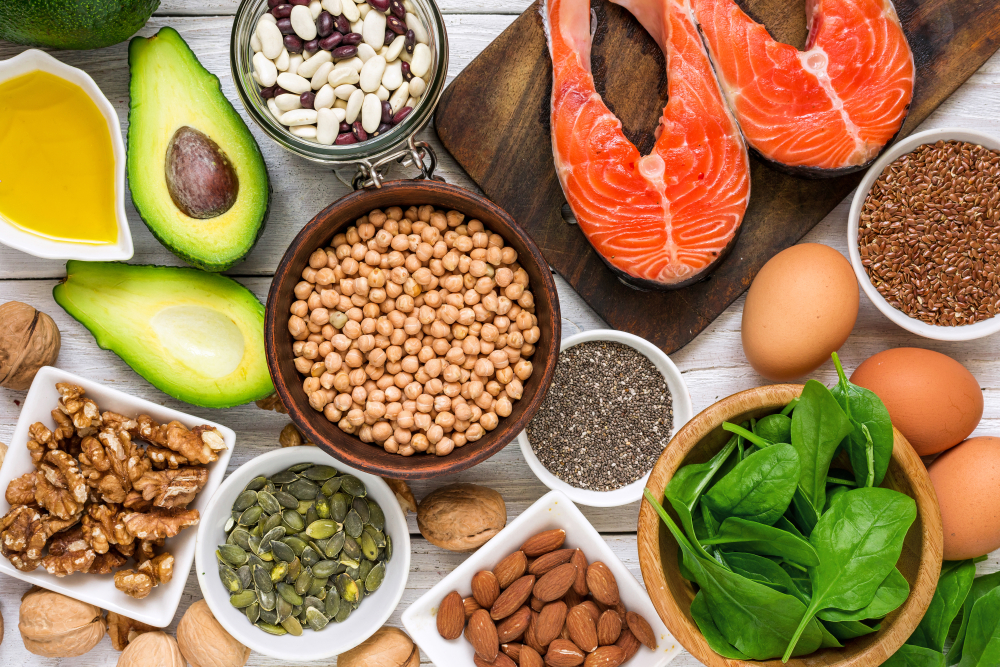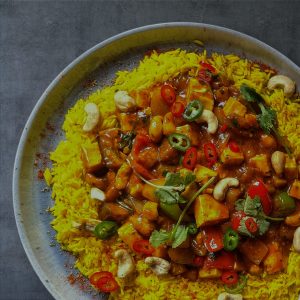Do you know the difference between HDL and LDL Cholesterol, omega 3 and omega 6, or how much saturated fat is too much?
With everyone turning their thoughts to healthier living post-Christmas, perhaps with the hope of losing a few pounds, understanding fats and the fact that they may not all be Public Enemy Number One, could be key.

“Generally, I think fats are perceived as bad for us, but the key is not the amount of fat we consume but the type”, says Dr Lucy Williamson, award-winning nutritionist and gut health expert.
“Fats play many important roles in maintaining our health and, contrary to popular belief, they’re less of a villain when it comes to weight control; sugar is our main enemy there!”
Here Lucy answers some often asked questions about fats that might just redeem their reputation!
- Why do we need fat in our diet?
Different types of fats are essential for the proper functioning of various processes in our bodies. They help us absorb fat-soluble vitamins, provide a concentrated energy source, and enhance the flavour of our food. So small amounts of fats are an important part of a healthy, balanced diet.
- How much fat should we include in our diet?
Current health advice recommends that our total fat intake should be no more than one third (35%) of our daily energy, with a maximum of 11% from saturated fat. This translates to 70 grams of total fat for women (20 grams from saturated fat for women and 75 grams for men (30 grams from saturated fat for men.
Here’s a practical example of this:
- Breakfast: Muesli and fruit with semi-skimmed milk
- Lunch: A jacket potato with tuna mayonnaise and salad, plus two oatcakes with cheese and grapes
- Snack: Guacamole with pitta bread
- Dinner: Vegetable curry with brown rice
- Dessert: Four squares of dark chocolate
If you were to add a single slice of chocolate brownie from a supermarket into this, containing about 14.1 grams of fat (8 grams of which are saturated), you would quickly exceed the recommended fat limits!
- What’s the difference between saturated and unsaturated fats?
How a fat behaves in our body depends on the balance of fatty acids it contains. These are either saturated (solid at room temperature) or unsaturated (liquid at room temperature). All fats in our food contain both types but animal fats are mainly saturated and plant fats (oils) are mainly unsaturated. We should aim to eat far more unsaturated fats as these are generally healthier.
- Are saturated fats always bad and unsaturated fats always good?
Too much saturated fat in the diet can increase the risk of high cholesterol, a key risk factor for heart disease and stroke. Unsaturated fats, on the other hand, can help to reduce this LDL, or ‘bad’ cholesterol when eaten in moderation, which is why they are generally seen as ‘good’ fats. (The exception to the rule is ‘trans fats’ – a type of unsaturated fat which can be formed when processing unsaturated fats into a solid form. These ‘hydrogenated’ vegetable products have largely been removed by manufacturers now as they increase ‘bad’ cholesterol in the blood)
- What benefits do unsaturated (monounsaturated fats and polyunsaturated) fats provide?
Monounsaturated fats, or MUFAs, are one of the beneficial nutrients in the Mediterranean Diet, olive oil being a great example. They can help reduce cholesterol levels while also providing important nutrients for your body’s cells. Meanwhile, two main polyunsaturated fats, or PUFAs, are Omega 3 and 6. Of these, Omega 3 is especially important as it helps to protect against heart disease and has an important anti-inflammatory role. Oily fish or marine life (think seaweed and algae) are our main source of Omega 3 hence why we should aim to eat fish twice weekly.
- So, what’s the story with seed oils, especially Rapeseed oil (Canola oil in the US) which is often referred to as the worst offender?
There are 3 big issues here:
- Chemicals used in their extraction
- Their high levels of Omega 6 and links with inflammation
- They are in many ultra processed foods (UPFs)
So, what do we need to know?
- Firstly, a shout out for British cold-pressed rapeseed oil – there are no chemicals used in the extraction of its oils (this is also the case with extra-virgin olive oil) and it’s better for our planet too – UK nature-friendly farmers have pioneered this approach – not least Hillfarm Oils in Suffolk. Rapeseed oil also has a really high smoke point so it’s a great choice for cooking at high temperatures and it has the least saturated fats of all plant oils.
- Omega 6 levels in seed oil – being an essential oil we’re totally dependent on getting Omega 6 from our food. It’s vital for blood clotting and to keep all our body cell walls healthy. There is a concern that Omega 6 drives inflammation in our bodies, but we know from robust research that as long as we have plenty Omega 3 in our diet from fish and plant oils, this isn’t a worry. Cold pressed rapeseed oil contains more omega 3 than any other seed oil.
- UPFs – Seed oils are in many ultra processed foods. We know these foods are linked with poor health outcomes, often rooted in inflammation, but these foods also have higher salt and sugar content, contain additives and are mechanically altered; far more likely to be the health issue here than the seed oils. Nevertheless, they’re an example of how we tend to consume more Omega 6 then 3 without even realising we are!
7. What are the key points about fats for Cholesterol?
- Choose mostly unsaturated fats from fish & plants. (fibre is also very beneficial for cholesterol lowering so it is plants all the way.
- Keep animal saturated fats to a minimum and choose reduced fat dairy options.
- Plant sterols – these are found naturally in vegetable oils, nuts, seeds, fruit and vegetables. They can lower LDL cholesterol and in some cases may reduce the dose of medication needed, like statins.
8. What about other plant oils – fad or fact?
- Coconut Oil – good for hair and skin but as it has a lower smoke point and is higher in saturated fats than most plants, I recommend sticking to dairy milk or other plant drinks. It’s certainly best avoided if heart health or cholesterol is an issue.
- Palm Oil – Semi-solid at room temperature, it can keep spreads spreadable, give products a longer shelf-life & give fried products a crispy texture compared to other vegetable oils. It’s also a very efficient crop, producing big harvests from small areas of land year-round, as a result it’s a driver of deforestation of some of the world’s most biodiverse places, and is also a much cheaper oil. Coconut oil and palm oil also contain far more saturated fats than other plant oils.
- Avocado Oil – with its Vitamin A, E and antioxidants as well as the same beneficial mono-unsaturated fat found in olive oil, it’s certainly a healthy choice and you can cook with it too, but there are some questions over how environmentally friendly avocados are.
- Walnut Oil – with its intense flavour and good levels of plant Omega 3, it’s a good choice for heart-healthy dressings, as is a handful of walnuts a day. Avoid cooking with it as it has a very low smoke point.
9. What should we know about Dairy fats?
We’ve focussed on plant fats as they’re generally healthier. But there’s exciting new research which is consistently showing that certain saturated fats found only in whole Dairy products help to protect heart health and reduce risk of Type 2 Diabetes. This is emerging research so it’s not yet part of public health advice, but the tide is turning with Dairy! Choose organic for a more nature-friendly version or you may be lucky enough to have a dairy farmer near you selling pasteurised milk direct from the farm. Lastly, even whole fat dairy milk is only about 5% saturated fat and it’s rich in many other vital nutrients too, like calcium.
10. Best for Baking
Small amounts of butter in our diet may have an anti-inflammatory role and it gives a lovely richness to baking. For a lighter bake, try extra virgin olive oil or cold pressed rapeseed oil.
Time for clarity!
Here are my top 3 tips when considering fats in our food:
1. Dairy – a good choice for a nutritious food that’s relatively low in saturated fat. (Remember to choose semi skimmed if trying to reduce blood cholesterol though)
2. Consider sustainability – cold-pressed rapeseed oil is produced right here in the UK so you’re supporting our farmers as well as our nature and our health! Check out flavoured options – garlic, lemon or chilli can be a great way to get a burst of easy flavour in your cooking!
3. Extra-virgin olive oil – a wonderful flavour for cold dressings as well as being heart-healthy and nature-friendly too!
Try these delicious recipes packed with healthy fats and flavour:
Hot Chocolate Love in a Mug
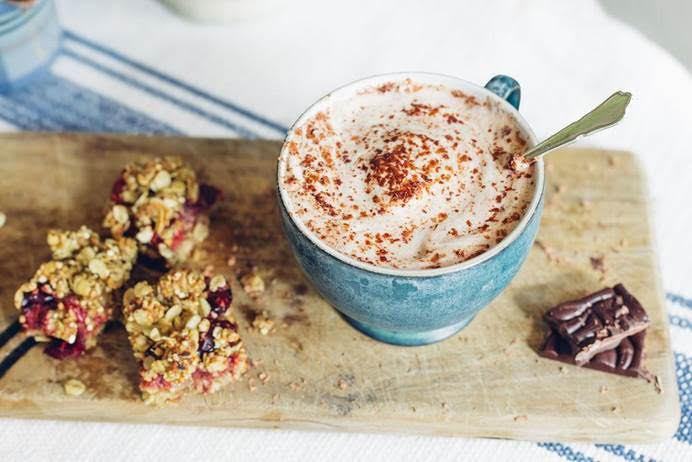
A mug of comfort – low sugar, high fibre and nutritious too. What’s not to love! Just scale up the amounts if you’re making for friends.
Serves 1
INGREDIENTS:
- 1 generous tbsp chopped dates
- 2 tsp cacao powder
- 1 piece (5g) 75% dark chocolate
- 50 ml oat drink (this type adds a little sweetness)
- Optional sprinkle of cinnamon
- 70 ml whole dairy milk
METHOD:
- In a small blender whizz together the cacao, dates and oat milk to a smooth liquid
- Heat this up until it thickens. I find it easiest to do this in a microwave but if doing several cups, it would be nice to do this in a small pan
- At the same time heat up the whole milk – I use a milk frother for this.
- Combine the hot milk and hot, thickened chocolate mix together in your favourite mug!
- Enjoy with a chunk of my homemade shortbread or grate a little extra dark chocolate on top.
Herb & Feta Crusted Baked Salmon
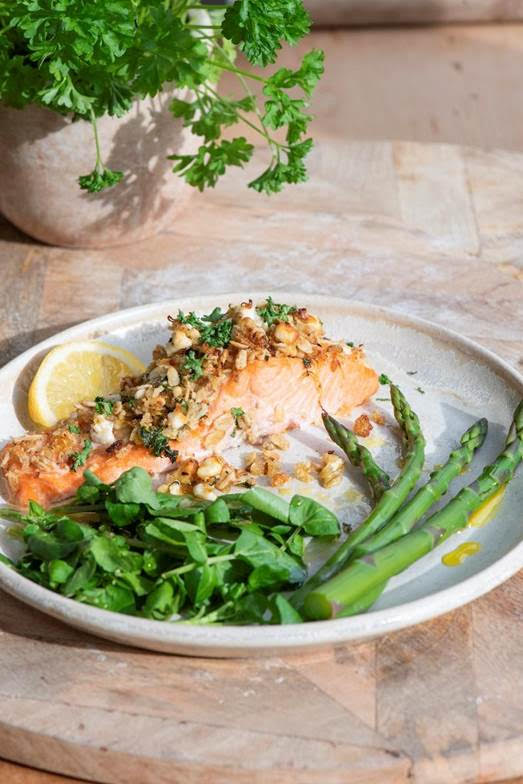
This also works with white fish of your choice. It’s bursting with flavour and the crumble topping soaks up all the healthy fish Omega 3 oils.
Serves 2
INGREDIENTS:
- 2 salmon fillets
- 1 tbsp cold pressed rapeseed oil
- 2 tbsp extra virgin olive oil
- Finely grated zest and juice of 1 lemon
- S&P
- Chopped mixed fresh herbs – mint and parsley work well
- 50g crumbled feta cheese
- 20g jumbo or porridge Oats & 20g stale breadcrumbs (if you don’t have breadcrumbs just double the oats)
METHOD:
- Heat the oven to 180 fan
- In a small mixing bowl mix together all of the above apart from the salmon, cold pressed rapeseed oil and lemon juice
- Place the fish in a baking tray and drizzle over the rapeseed oil and the juice of the lemon.
- Bake the fish for 8 mins
- Top with the herb/ feta/ oat mixture, roughly over both fillets. Some will just lie within the tray.
- Bake for a further 8 minutes.
- When serving make sure you spoon up the oil and herby mix from the tray – this way you don’t lose out on the healthy fish oils that leak out during baking. And it’s also delicious!
- Serve with carbohydrate of your choice if you need it; (remember the crumble topping is a nice bit of carbohydrate) A slice of sourdough and a little butter goes well and either veg or salad of your choice. If part of a weight loss regime, just have nice salad on the side and no further carbohydrate.
Winter Salad Bowl
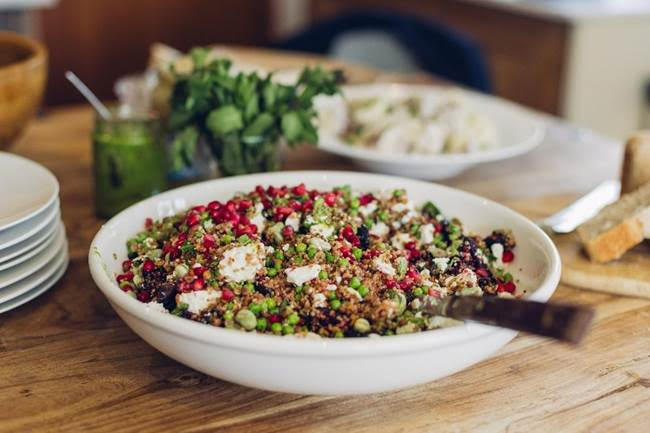
I love being able to vary this salad according to what’s in season and also flexibility on toppings – goats cheese, nuts and seeds – all full of healthy fats – what’s your favourite?
Serves 4 as a side or light lunch
INGREDIENTS:
- 1 cup coral whole (coral) lentils (these keep their shape really well)
- 1 cup quinoa
- juice of half a lemon
- ½ red onion finely chopped
- Winter veg of your choice – diced, cooked beetroot and sweet potato work really well
- 100g frozen peas
- 100g feta cheese, crumbled
- Fresh herbs – mint should be available and adds wonderful flavour
- 4 tbsps green pesto (either bought or my recipe)
- 4 tbsps extra virgin olive oil
- Salt and Pepper
METHOD:
- Cook the coral lentils until tender – about 15-20 minutes simmering either in salted water or use a nice chicken or vegetable stock. (whole lentils hold their shape well). Drain and set aside to cool. At the same time
- At the same time cook a batch of quinoa – save time and cook double so you have a batch in the fridge for other recipes. Pop the quinoa in a pan over heat and toast gently shaking it for 2 mins. Add twice the volume of cold water. It will bubble up. Cover and simmer for 10 minutes. Remove from the heat and leave, covered, for a further 10 minutes.
- Cook the peas and plunge straight into cold water so they keep their colour.
- Mix the lentils, peas, chopped herbs, beetroot, sweet potato and onions together. Add the lemon juice & olive oil and season to taste.
- Partly mix through the green pesto and drizzle over some extra virgin olive oil.
- Stir through crumbled feta and scatter the top with some pomegranate jewels!
Reduce waste
This is a great recipe for using up some leftovers – plan to enjoy a tray of roasted veg including the beetroot and sweet potato the night before and then they’re already cooked for you!
It’s time to rethink fats and be more aware of which fats you are eating, rather than just how much fat you are consuming, for a healthy lifestyle.
For more information about diet, gut health or to sign up for Lucy’s Gut Health Guide, visit www.lwnutrition.co.uk where you’ll also find more delicious recipes.

